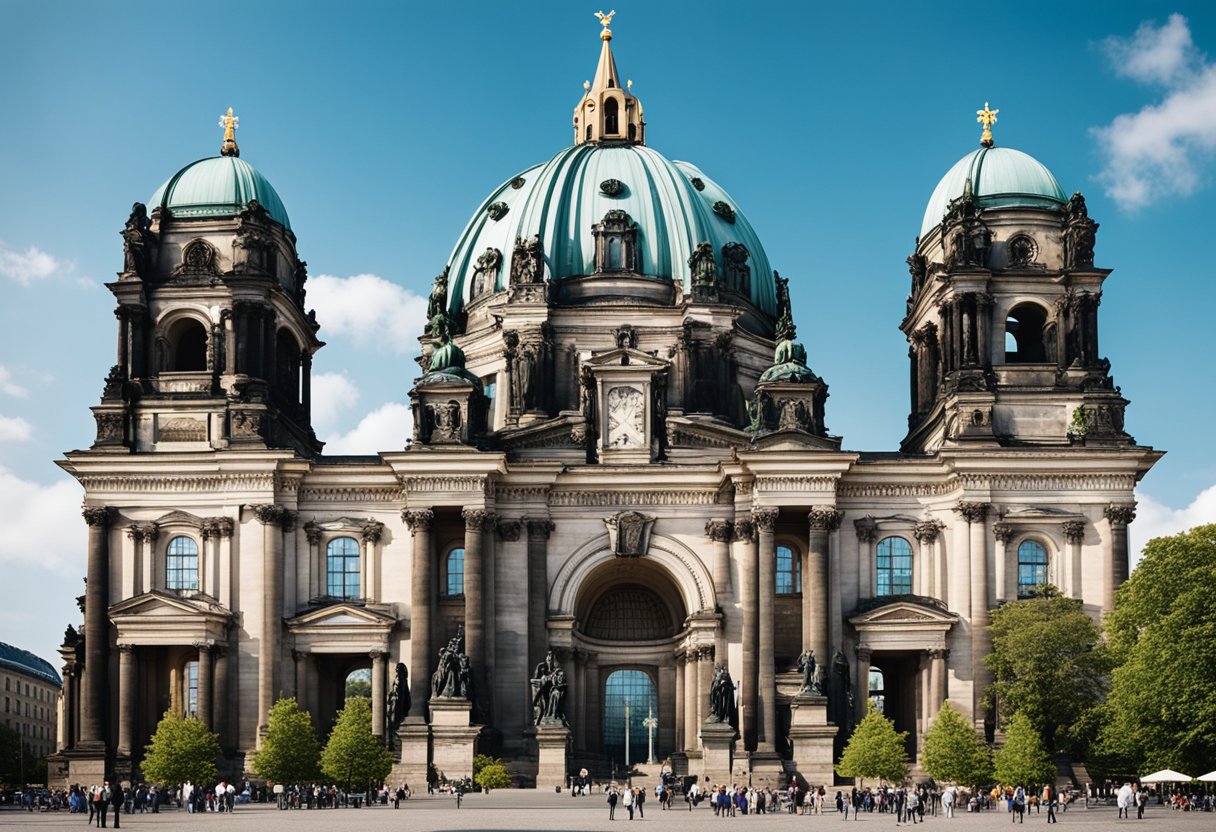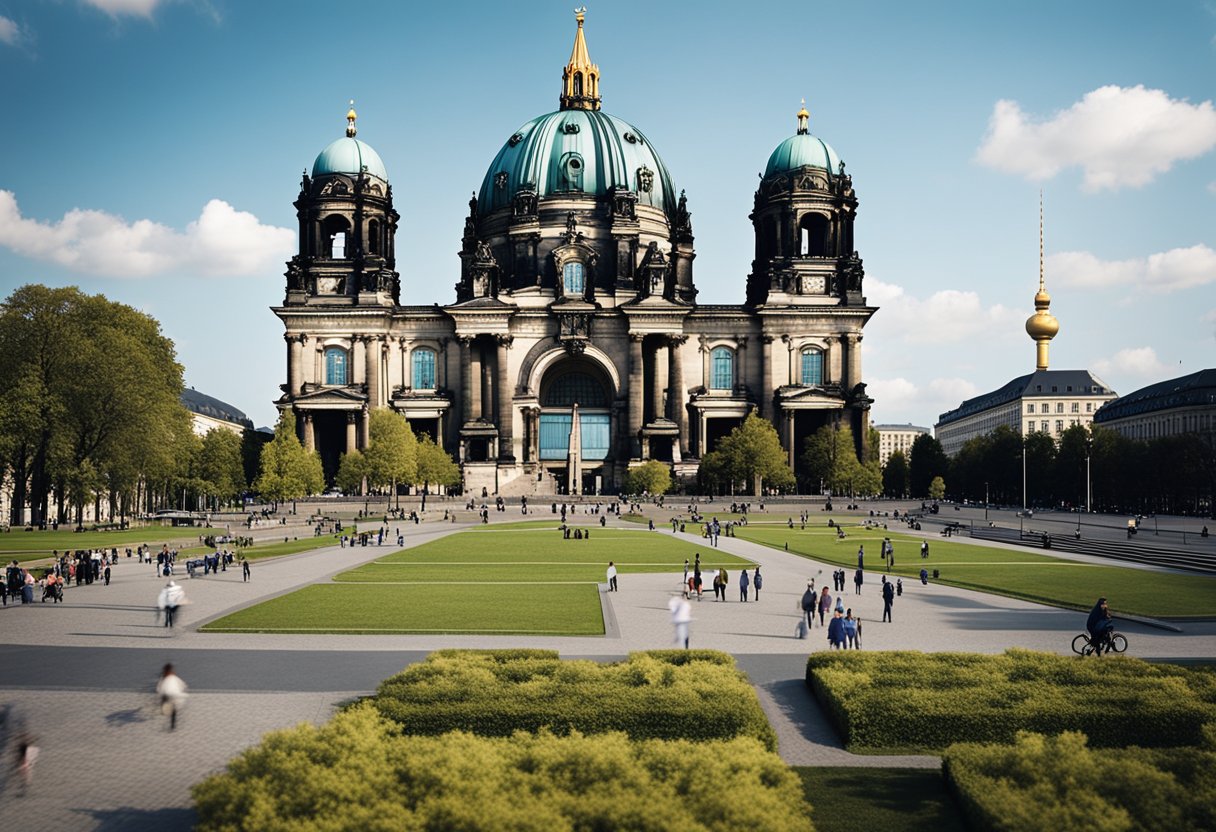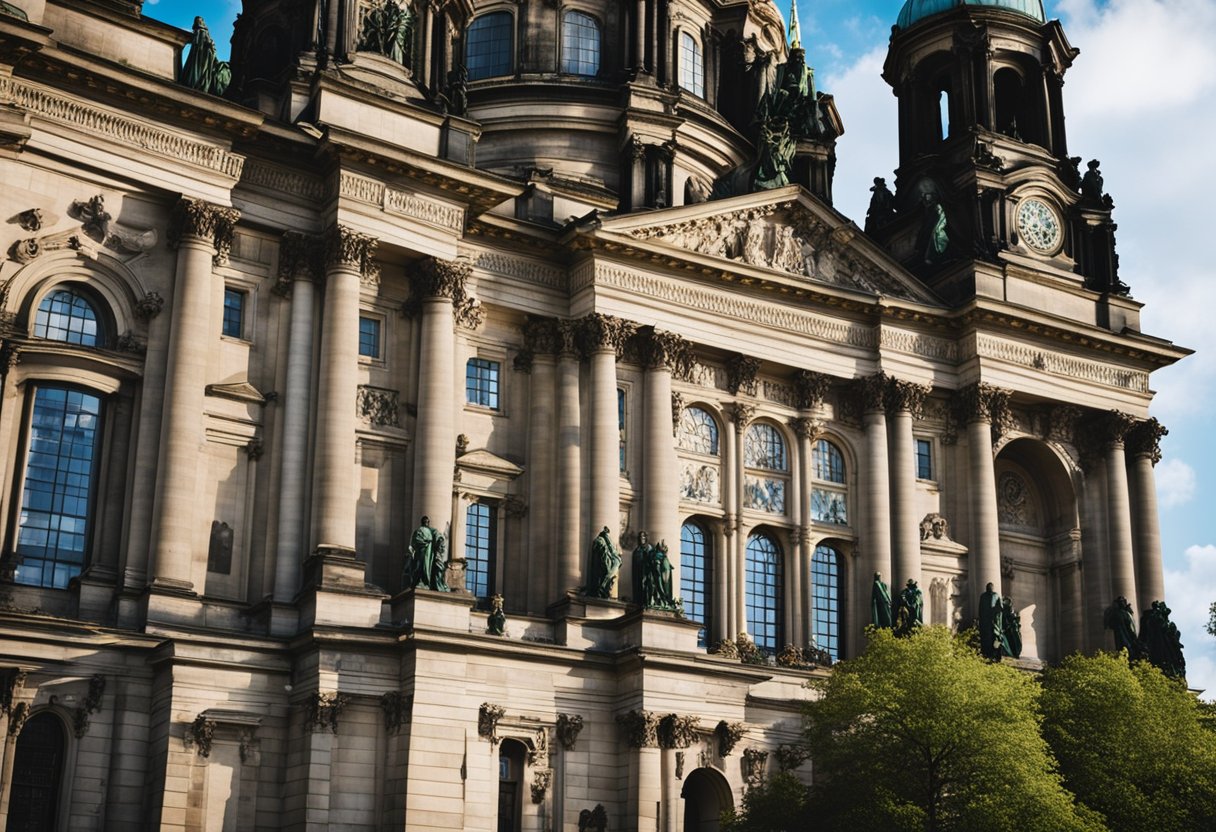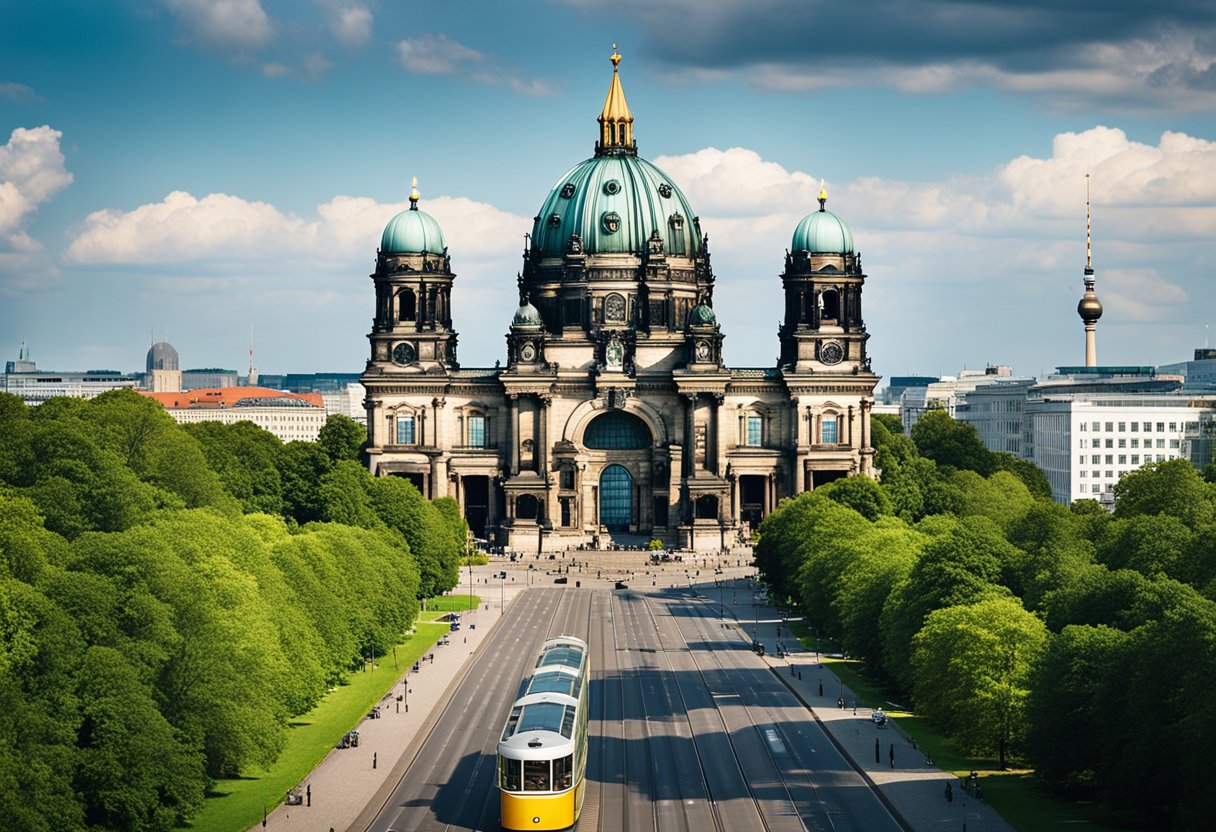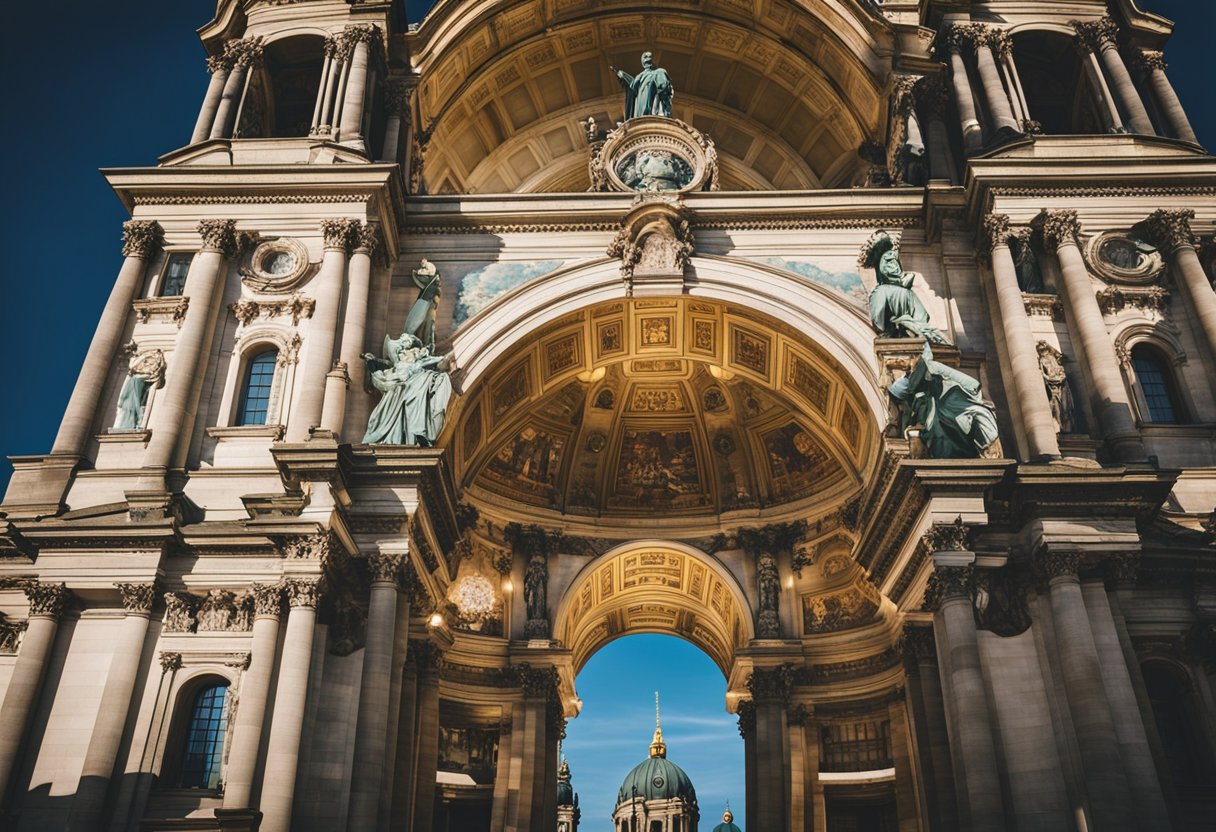Nestled in the cultural heart of central Berlin, the Berlin Cathedral (Berliner Dom) stands as a testament to centuries of architectural evolution and historical significance.
This grand edifice, with its commanding dome, is both a key spiritual center for the Protestant community and a prime example of Germany’s rich heritage.
Positioned on the Museum Island, adjacent to the calming green space of the Lustgarten, the cathedral is a magnet for visitors and locals alike, offering insights into the nation’s past and religious life.
The Berlin Cathedral not only serves as a place of worship but also as a historical treasure trove, with its foundations tracing back to a 15th-century chapel. Over time, it has been subject to numerous reconstructions and restorations, each contributing to the building’s current Neo-Renaissance and Baroque-influenced appearance.
Moreover, its significance is punctuated by its role as the dynastic tomb for the House of Hohenzollern, marking it as a monument of national importance.
The cathedral’s interior is a showcase of opulent design replete with intricate mosaics, elaborate paintings, and commanding sculptures that capture the eye and spirit.
Visitors seeking an elevated experience both metaphorically and literally can ascend to the dome, which presents an unparalleled panoramic view of Berlin’s cityscape. This, combined with its serenity and beauty, sets the Berlin Cathedral apart as a must-visit landmark in the German capital.
Historical Context
Berlin Cathedral, officially known as Supreme Parish and Collegiate Church, located at Am Lustgarten in Berlin, Germany, stands as a religious edifice with a storied past, intertwining with the nation’s history from its early days to the modern era.
Early Beginnings and Pleasure Garden
The origins of Berlin Cathedral trace back to a Roman Catholic worship site established in the 15th century. Its significance grew when, in 1451, it was declared as a Collegiate Church. The term “Lustgarten,” meaning pleasure garden, references the area’s initial use as a part of the royal gardens of the Berlin City Palace, a place for leisure and recreation for the nobility.
From Reformation to Empire
The impact of the Reformation hit in the 16th century, marking a shift in the church’s denomination from Roman Catholic to Protestant, reflecting broader religious changes across Europe.
During the era of the German Empire, specifically by 1905, the Cathedral had been transformed into a grandiose structure representing the Prussian power and influence under the Hohenzollern dynasty. This architectural marvel symbolized the empire’s prestige.
Impact of Wars and Reconstruction
Throughout the tumultuous years of the Weimar Republic, Berlin Cathedral witnessed numerous political events. The adversity continued during World War II, when the Cathedral suffered significant damage from bombs.
In the aftermath, reconstruction efforts took place, although the full restoration wasn’t realized until 1993. During the time of the German Democratic Republic, the Palace of the Republic stood adjacent to the Cathedral, representing the new political order.
The Cathedral’s history encapsulates key moments from the Reformation through the challenges of the Second World War, to its role in both the Weimar Republic and the German Democratic Republic.
Architectural Evolution
The Berlin Cathedral has undergone significant transformations since its inception, closely mirroring the changing architectural styles and influences of different periods in German history.
Initial Designs and Influence
The original church on the site of the Berlin Cathedral was influenced by Baroque architecture, a style that originated in Italy before spreading throughout Europe. One of the most prominent architects of the time, Karl Friedrich Schinkel, further influenced the evolution of the building with his Neoclassical approach.
The Altes Museum, situated next to the Berlin Palace and part of the same Museum Island complex, reflects Schinkel’s influence with its clear Classicist Style derived from the Italian High Renaissance, reminiscent of iconic structures such as St. Peter’s Basilica.
Rebuilding and Restoration
In the late 19th century, under the direction of Julius Carl Raschdorff, the Berlin Cathedral underwent a major reconstruction which transitioned its style to the Neo-Renaissance. This was a part of Germany’s desire to create a national identity through architecture, using Renaissance and Baroque revival styles.
The demolition of the previous structure allowed for Raschdorff’s grand vision of a cathedral that would not only serve as a place of worship but also as a symbol of the imperial power and cultural significance of Germany at the time.
Berlin Cathedral Today
The Berlin Cathedral stands as a beacon of Protestant faith and a monumental tourist attraction, harmoniously uniting its sacred purpose with its cultural significance.
Religious Significance
Berlin Cathedral, or Berliner Dom, proudly remains a central place of worship for the Evangelical Church in Germany, which encompasses both Lutheran and Reformed traditions.
Within its grand structure, services, sermons, and religious ceremonies take place, including weddings, baptisms, and confirmations in the Baptismal and Matrimonial Chapel. The St. Erasmus Chapel, dedicated to a significant figure in Christian history, adds to the spiritual ambiance of the Cathedral.
Cultural and Tourist Attraction
From a cultural perspective, the dome of the Cathedral, which visitors can climb, offers breathtaking views of Berlin. The site also serves as a venue for concerts, adding a musical dimension to its appeal.
Tourists flock to the Berlin Cathedral, drawn by its architecture and historical significance, including its role as the parish church for the Hohenzollern family. Easily accessible via S-Bahn and tram, it stands near other monuments on the Museum Island, enriching the experience of both history enthusiasts and casual visitors alike.
Surrounding Areas and Transportation
The area surrounding Berlin Cathedral and Lustgarten is a cultural and historical hub, offering visitors a rich landscape of parks and museums, as well as efficient transportation options for navigating Central Berlin.
Lustgarten and Vicinity
Lustgarten, a key component of Museum Island, is fringed by significant landmarks including the Berliner Dom and Berlin City Palace. This park serves as a verdant anchor in the cityscape with its well-maintained landscape that includes the famous large granite bowl and a variety of statues.
The park itself has witnessed numerous marches and historical events, complementing the solemnity of the Museum Island ensemble. The river Spree adds to the serene atmosphere, bordering the northern side of the gardens.
Accessibility and Orientation
Getting to Berlin Cathedral and the surrounding Lustgarten is convenient thanks to Berlin’s comprehensive public transport system. Options include train lines such as S1, S25, S5, and S7, which facilitate ease of access to this central location (see transit lines that pass near Berliner Dom).
Visitors can also utilize the underground network to reach the vicinity. For ease of navigation, the area is equipped with information map views conspicuously displayed, helping pedestrians and tourists orient themselves amid the historical and architectural wonders of the park and its surroundings.
Cathedral Details and Artwork
Berlin Cathedral, a striking edifice in the heart of the city, houses a wealth of art and historical significance, with its opulent interior and royal tombs offering insight into Germany’s past grandeur.
Interior Design and Artifacts
The majestic interior of the Berlin Cathedral is adorned with a variety of materials, including white marble and onyx, contributing to the rich and ornate aesthetic. Central to the cathedral’s interior grandeur is the impressive Sauer Organ, an intricate piece hailed for its powerful sound.
The ceiling is graced by a Golden Cross that crowns the dome, inviting admiration from visitors and worshipers alike. Additionally, the sacred music ensembles, Domkantorei and Staats- und Domchor Berlin, add to the cathedral’s cultural and historical depth, contributing to its status as a Collegiate Church.
Crypts and Royal Connections
Beneath the main structure lies the Hohenzollern Crypt, known as one of the most significant dynastic burial places in Europe. This crypt holds the remains of the Hohenzollern Dynasty, including figures such as Elector Joachim II and Frederick the Great, thus marking the cathedral’s significance as a historical monument.
Architect August Stüler played a key role in the cathedral’s design, ensuring it remained a fitting resting place for the royalty and a true testament to their legacy.
Gardens and Public Spaces
The landscaped expanse of Lustgarten offers a historical and cultural retreat next to the imposing Berlin Cathedral. It serves as a link between Berlin’s past and the leisure needs of today’s city dwellers and tourists.
Lustgarten’s Historical Role
Initially part of the Berlin City Palace, the Lustgarten has undergone multiple transformations since its inception. Designed by Peter Joseph Lenné, the area evolved from a Herb Garden of the electors to a Parade Ground for military displays.
In its early days, the Lustgarten was a symbol of regal prestige, showcasing an array of fruit trees and elaborate fountains. Adjacent to the site, one finds the Deutsches Historisches Museum, which provides context and contrasts to the serene surroundings of the garden.
Modern-Day Recreation and Layout
Today, the Lustgarten has been reimagined as a Pleasure Garden, maintaining its allure as a tranquil enclave. The layout encourages leisure activities, with open lawns and pathways for visitors to stroll and relax.
Central to this modern layout is a large fountain that becomes a focal point for gatherings and social interaction.
Visitors can also appreciate the historical significance that seamlessly blends with the contemporary use of space, creating a unique urban experience beside one of Germany’s most notable religious landmarks, the Berlin Cathedral.
Historical Entities and Influence
The Berlin Cathedral and its surrounding area, known as the Lustgarten, encapsulate a timeline of significant figures and architectural marvels that have shaped Berlin’s cultural and historical landscape.
Influential Figures and Events
Wilhelm II, the last German Emperor, played a pivotal role in the history of the Berlin Cathedral, overseeing its completion in its current form in 1905. His reign was marked by a push for greater German influence on the world stage, an ambition reflected in the Cathedral’s grandeur and the broader cityscape’s development.
Wilhelm II’s impact is inseparable from the history of the site, making the Cathedral a testament to this era of German history.
Johann Boumann the Elder is known for contributing to Berlin’s architectural heritage, including designing part of the Old Museum. His work laid the foundation for the neoclassical style that would come to characterize many of Berlin’s iconic buildings.
Historical Monuments and Structures
The Berlin Cathedral, situated in the historic heart of the city, is a primary architectural monument that has stood through eras of remarkable change. Partly destroyed during World War II, it was later restored, symbolizing resilience amid adversity.
The Altes Museum, which faces the Cathedral across the Lustgarten, was designed by Karl Friedrich Schinkel and is another example of Berlin’s neoclassical architectural prowess.
Together with the Berlin City Palace and the Old Museum, these buildings form a quartet of historical structures that have been central to the city’s identity, bearing witness to changing ideals and tastes over the centuries.
Adjacent to these edifices, the Lustgarten has seen countless sights and monuments come and go, reflecting the turbulent history of Berlin itself. Each stone and statue tells a story, contributing to the rich tapestry that is Berlin’s past.
Restoration and Preservation Efforts
Berlin Cathedral has undergone significant restorative efforts after facing considerable damage during past conflicts. These efforts have aimed to preserve a key piece of Germany’s cultural heritage while also overcoming numerous challenges.
Post-War Challenges
After being heavily damaged in World War II, Berlin Cathedral faced a long road to its former glory. Restoration work began in earnest by 1975, with the East German government taking a principal role.
The foundation stone of the current cathedral, laid much earlier in the history of the building, became symbolic of the enduring nature of Berlin’s spirit in the face of destruction. Efforts were hampered by political and economic hurdles, but the dedication of individuals such as Rüdiger Hoth, who diligently worked on the reconstruction, ensured progress continued.
21st Century Developments
In the 21st century, new developments in preservation technology and methods have allowed for enhanced restorative work on Germany’s Berlin Cathedral.
Notable restorers include Michael Hanf, whose attention to detail and craftsmanship have contributed greatly to the preservation efforts of the cathedral’s intricate features.
With Germany’s Copyright laws, capturing the essence and originality of the artwork and architecture during restoration has been a careful balance between innovation and respect for historical accuracy. The merging of the old with the new embodies the cathedral’s continued relevance and its importance as a beloved landmark in Berlin.
Frequently Asked Questions
In this section, readers can find answers to some of the most common queries regarding Berlin Cathedral. From ticket prices and historical facts to visiting hours and significant burials, this compilation provides an essential guide for anyone planning a visit.
What are the ticket prices for visiting Berlin Cathedral?
The entrance fee for Berlin Cathedral varies based on age group and concessions, with free entry for children under a certain age.
Can you provide a brief overview of Berlin Cathedral’s history?
Berlin Cathedral has served as a significant spiritual and architectural landmark since its inauguration, with a history entwined with that of the Hohenzollern dynasty.
What are the regular mass times at Berlin Cathedral?
Regular mass and service times can be found on the official Berlin Cathedral website or by visiting the cathedral, where locals often attend evening services to experience the atmosphere without the bustle of tourists.
What are Berlin Cathedral’s opening hours?
The opening hours of Berlin Cathedral vary throughout the year, and it’s advisable for visitors to check the current times before planning their visit.
Which notable figures are interred within Berlin Cathedral?
Berlin Cathedral is the final resting place for various members of the Hohenzollern family, adding a rich historical layer to its already impressive architectural features.
Is there an entrance fee to visit Berlin Cathedral?
As previously noted, there is an entrance fee for Berlin Cathedral, which contributes to its maintenance and preservation for future generations to admire.
